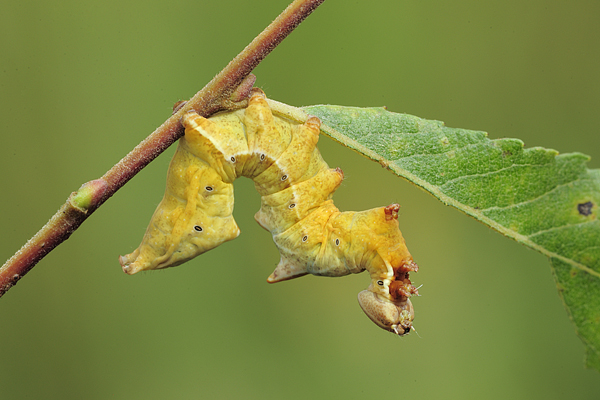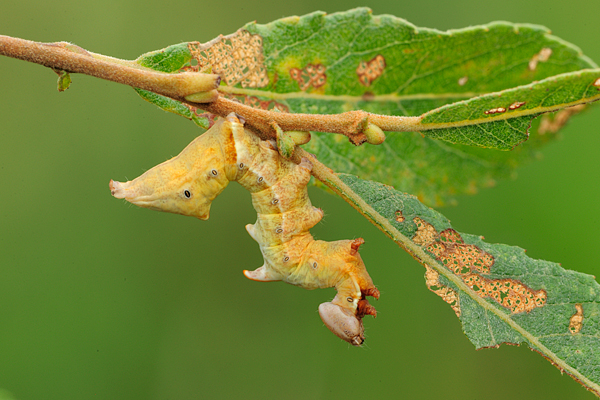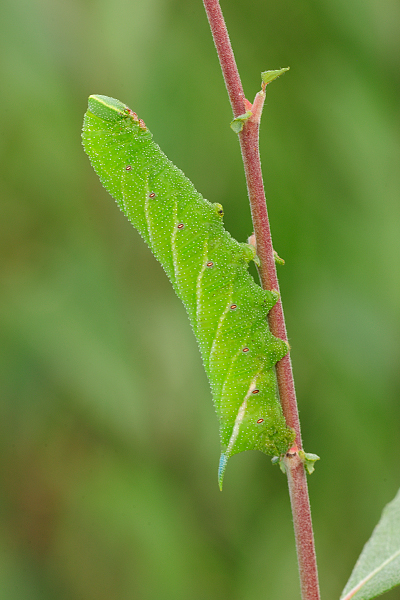The caterpillar trail
Life in the foliage
I was in a local nature reserve finishing off a photography contract on dragonflies for a new field guide and in the late afternoon when conditions became cooler, and the skies clouded over I spent a couple of hours searching a number of small sallow bushes in a sheltered spot near the dragonfly pools for caterpillars.
August and September are the optimum months to find and photograph the larval stages of a wide variety of moths. Towards the end of summer, most are entering their final instar and are often more conspicuous on the foliage.
The area where I was working is quite exposed and the wind was fresh making photography that bit more challenging.
Top image: photographed with a Nikon 24mm wide angle lens against the sky. Above: mature larva in typical resting posture, Nikon 200mm macro.
The larva of the Pebble Prominent Notodonta ziczac is an interesting species and when at rest adopts a curious posture. The larvae have curiously shaped raised appendages amongst the final segments. The colour of individuals is quite variable ranging from green through to brown. The raised projection along the back of the caterpillar is often a good identification indicator.
Photographing caterpillars, can at times, be a really frustrating experience. It is always advisable to photograph them in-situ and try not to disturb them if at all possible, if you want to photograph them in their natural postures. If disturbed, they start to wonder about, which can last on for some time, making it a frustrating experience for the photographer.
Above: another slightly smaller larva on a different branch, Nikon 200mm macro lens, tripod.
Other species I discovered were larvae of the Eyed Hawk-moth Smerinthus ocellata. This is a handsome species with a blue horn-like projection on the end of the last segment; this is a characteristic found in all the hawk-moth species in some shape or form. The larva also has oblique stripes running across the segments and adopts sphinxlike posture when at rest. This particular larvae was well up the stem, and fairly easy to spot? Other clues for larval activity include partially striped leaves and frass (caterpillar droppings), which are often seen, trapped among the leaves.
Above: mature larva in sphinxlike resting posture, Nikon 200mm macro, tripod, stem stabiliser.
The windy conditions made the larvae challenging to photograph. I was forced to increase the ISO and used a stabilising device (Wimberley Plamp) attached to the main stem to reduce the movement. I’m not a big fan of this device, (despite its popularity) for a number of reasons, which is why I designed my own a number of years ago (see Close-up and Macro A photographers guide). I normally carry my own device with me, but had not planned to do any close-up work that would require it. I tend use the Plamp mainly to hold a diffuser, but prefer my own stabiliser when working on plants. Perhaps I should do an article on the merits of both at some point?
Above: overview of the small sallow shrub showing position of larva.
Above: Plamp in position to help stabilise the branch.
There were also a number of Sawfly larvae, which are often confused with the caterpillars of butterflies and moths, but can be easily separated by counting the number of prolegs. The larvae of butterflies and moths can have up to five pairs, whereas sawfly larvae will have six or more. Another more subtle difference is the tiny hooks at the end of the prolegs, which are present in butterflies and moths, but absent in sawfly larvae. Nevertheless, sawfly larvae can be quite photogenic and are always worth spending a little time with!







